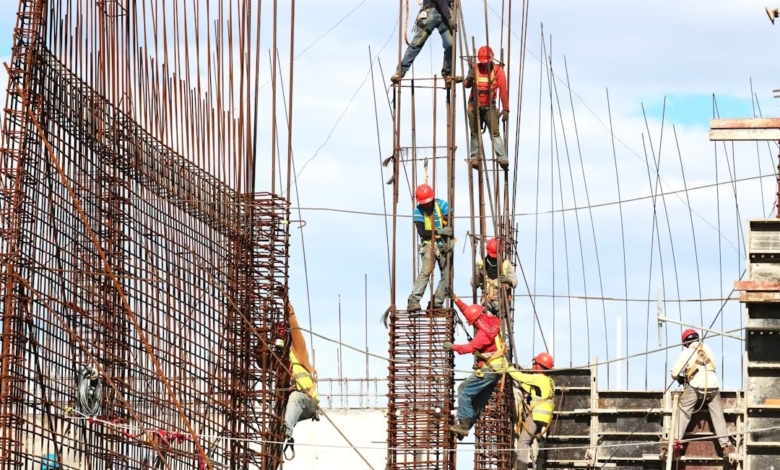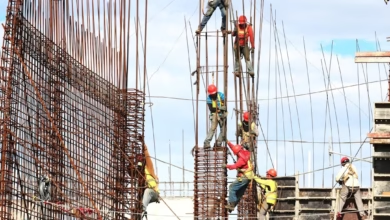The Essential Guide to Construction Metals: Steel, Aluminum, and Innovative Trends in Sustainable Building Materials

In the ever-evolving landscape of construction, the choice of building materials plays a pivotal role in determining the efficiency, sustainability, and durability of structures. Among these materials, construction metals such as steel, aluminum, copper, and zinc stand out not only for their strength and versatility but also for their economic and environmental implications. Understanding the distinction between ferrous and non-ferrous metals is essential to grasp the various applications of metal alloys in today’s construction projects. As industries increasingly pivot towards sustainable metal production, innovations in metal recycling and metallurgy are paving the way for more eco-friendly building practices. Furthermore, exploring current metal trends sheds light on how industrial metals are shaping the future of construction and fabrication, from 3D printing metals to advancements in energy and automotive sectors. In this article, we will delve into the critical role of construction metals, the significance of sustainable practices, and the emerging trends that are defining the metal commodities market, including precious metals like gold and silver, as well as rare earth and battery metals. Join us as we uncover the intricate relationship between these materials and the future of building and infrastructure.
- 1. The Role of Construction Metals: Understanding Ferrous and Non-Ferrous Metals in Building Materials
- 2. Sustainable Metal Production: Innovations in Metal Recycling and Metallurgy for Construction
- 3. Exploring Metal Trends: The Impact of Industrial Metals on the Future of Construction and Fabrication
1. The Role of Construction Metals: Understanding Ferrous and Non-Ferrous Metals in Building Materials
In the construction industry, metals play a pivotal role as essential building materials, categorized primarily into two groups: ferrous and non-ferrous metals. Understanding these classifications is key to appreciating their unique properties and applications in construction.
Ferrous metals, which contain iron, are known for their strength and durability. Steel, a prominent ferrous metal, is widely utilized in structures due to its remarkable tensile strength and flexibility. It is integral in frameworks, beams, and reinforcements, making it a staple in construction projects. Additionally, metal alloys such as stainless steel, which incorporates chromium and nickel, offer enhanced corrosion resistance, making them suitable for various applications, including roofing and cladding.
On the other hand, non-ferrous metals do not contain significant amounts of iron, which contributes to their unique characteristics. Aluminum is a prime example of non-ferrous metals, celebrated for its lightweight nature, resistance to corrosion, and excellent thermal conductivity. These properties make aluminum a popular choice for window frames, doors, and roofing materials. Other non-ferrous metals like copper and zinc are also vital in construction; copper is commonly used in electrical wiring and plumbing, while zinc is often used as a protective coating to prevent metal corrosion.
The rise of sustainable metal production has led to an increased focus on metal recycling, helping reduce the environmental impact of construction. By recycling metals, such as aluminum and copper, the industry can significantly lower energy consumption and minimize waste. This practice aligns with current metal trends toward sustainability and efficiency.
In recent years, there has been a notable interest in rare earth metals and their applications in cutting-edge technologies, including construction. These metals are increasingly integrated into advanced building materials and energy-efficient systems, demonstrating the evolving landscape of metallurgy.
Lastly, with the advent of innovative manufacturing techniques like 3D printing metals, the construction sector is witnessing a transformation. The ability to create custom metal components on-demand not only reduces material waste but also allows for greater design flexibility. This trend is particularly beneficial in specialized sectors such as aerospace and automotive, where precision and performance are paramount.
In summary, the role of construction metals—both ferrous and non-ferrous—extends far beyond mere structural support. Their diverse applications and ongoing advancements in metallurgy and metal fabrication are reshaping the future of building materials, paving the way for more sustainable and efficient construction practices.
2. Sustainable Metal Production: Innovations in Metal Recycling and Metallurgy for Construction
Sustainable metal production is becoming increasingly essential in the construction industry, particularly as the demand for eco-friendly practices rises. Innovations in metal recycling and metallurgy are key to achieving sustainability in the use of construction metals such as steel, aluminum, and copper.
Metal recycling has undergone significant advancements, allowing for the recovery and reuse of industrial metals from various sources. By recycling ferrous metals like steel and non-ferrous metals such as aluminum, we can reduce the need for new metal mining, which often comes with a hefty environmental cost. Modern techniques in metal fabrication have enhanced the efficiency of recycling processes, making it easier to convert scrap metals back into high-quality raw materials for new construction projects. This not only conserves energy but also minimizes metal corrosion and waste, contributing to a more sustainable lifecycle for construction materials.
Moreover, innovations in metallurgy are transforming how metals are produced and used in construction. The development of new metal alloys, which combine base metals like zinc and copper with other elements, has led to stronger, lighter, and more durable materials. These advanced alloys can significantly reduce the amount of metal needed for construction, thereby lowering the overall carbon footprint.
Additionally, the growing trend of 3D printing metals is revolutionizing the construction landscape. This technology allows for the precise fabrication of complex metal structures, reducing material waste and enabling the use of unique metal commodities that were previously challenging to work with. For instance, aerospace metals and battery metals are being integrated into construction applications, opening up new possibilities in building design and functionality.
Rare earth metals and precious metals, such as platinum and palladium, also play a role in sustainable construction practices. Their unique properties can enhance the performance of construction materials, making them more efficient and longer-lasting. As more builders and architects explore the potential of these metals, we can expect to see a shift towards more innovative and sustainable building practices.
In conclusion, the future of sustainable metal production in construction lies in the continuous improvement of metal recycling and metallurgy. By embracing these innovations, the construction industry can significantly reduce its environmental impact while meeting the growing demands for durable and efficient building materials. As we move forward, keeping an eye on metal trends and investing in sustainable practices will be crucial for building a greener future.
3. Exploring Metal Trends: The Impact of Industrial Metals on the Future of Construction and Fabrication
The construction and fabrication industries are witnessing significant changes driven by emerging metal trends. As we move towards a more sustainable future, the use of industrial metals is evolving, influencing everything from building design to material sourcing.
One of the most notable trends is the increasing focus on sustainable metal production. The construction sector is adopting more environmentally responsible practices, including metal recycling, which reduces the need for new metal mining. This shift not only conserves resources but also minimizes metal corrosion issues associated with traditional manufacturing processes. By recycling ferrous and non-ferrous metals like steel and aluminum, builders are able to significantly reduce their carbon footprint while still maintaining the strength and durability required in construction.
Moreover, the rise of advanced metallurgy has led to the development of innovative metal alloys tailored for specific applications in construction. For instance, aerospace metals and automotive metals are being adapted for use in buildings, offering enhanced performance characteristics such as improved strength-to-weight ratios and resistance to corrosion. The integration of 3D printing metals into construction practices also allows for more intricate designs and reduced waste, further promoting sustainability.
In addition to these trends, the investment landscape for metals is evolving. Gold investing and silver investing remain popular, but there is a growing interest in base metals like copper and zinc, which are critical for infrastructure development. Additionally, the demand for battery metals such as lithium, platinum, and palladium is surging as the construction industry looks to incorporate renewable energy solutions.
As the future of construction unfolds, the interplay of these metal trends will shape the landscape of building materials. The impact of industrial metals on construction and fabrication is profound, driving innovation while ensuring that sustainability remains at the forefront of industry practices. Keeping an eye on these trends will be crucial for stakeholders in the construction sector to remain competitive and environmentally conscious.
In conclusion, the significance of construction metals, including both ferrous and non-ferrous varieties, cannot be overstated in the modern building industry. As we explore innovations in sustainable metal production, it becomes clear that metal recycling and advancements in metallurgy are pivotal for reducing environmental impact while meeting the growing demand for materials. The emerging trends in industrial metals, particularly with the integration of rare earth metals and advancements in 3D printing metals, are shaping the future of construction and fabrication, pushing boundaries in efficiency and design.
Moreover, as the focus on sustainability intensifies, the industry must adapt by embracing base metals like steel, aluminum, copper, and zinc, alongside precious metals such as platinum and palladium, which have applications beyond traditional construction, including in aerospace and automotive sectors. The ongoing evolution of metal commodities highlights the importance of strategic investments, such as gold and silver investing, to ensure that resources are allocated efficiently in a rapidly changing market.
As we move forward, understanding and leveraging the properties of various construction metals will be crucial in combating challenges like metal corrosion and enhancing the durability of structures. The future of construction lies in our ability to innovate, adapt, and responsibly utilize these essential materials, ensuring that we can build sustainably while meeting the demands of an ever-evolving world.
References
(Include relevant citations here)





